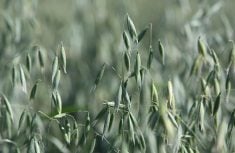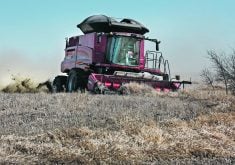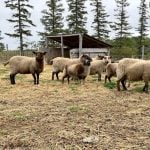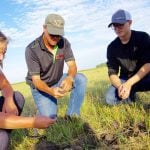Feedloting foals
A study done for Alberta Agriculture by Lakeside Research of Brooks in 1981 that is still relevant tracked the feedlot performance of weanling foals. It analyzed the feeding program followed by most horse feedlots, where weanlings from PMU farms are put directly into feedlots and fed a ration of grain and forage.
Ninety foals of mixed genetic background and sex were fed in a beef feedlot facility with bunkline feeders, 20 percent porosity wind breaks and automatic waterers. Horses were divided by sex and averaged for weight. Initial weight was 230 kilograms.
Read Also

VIDEO: Ag in Motion documentary launches second season
The second season of the the Western Producer’s documentary series about Ag in Motion launched Oct. 8.
Three dietary treatments were as follows:
- Cube ration- 70 percent alfalfa cubes, 30 percent oat-based concentrate .
- Oat ration- 30 percent alfalfa cubes, 70 percent oat-based concentrate.
- Barley ration – 30 percent alfalfa cubes, 70 percent barley-based concentrate.
Horses were fed free-choice long hay for two days when they arrived at the feedlot. Then 1.4 kg of oats were added to their diets. Before the trial, alfalfa cubes were substituted for long hay over a period of three days. Horses on high-grain diets were fed 30 percent concentrate for three days and 50 percent concentrate for four days prior to feeding the 70 percent concentrate diet.
Horses were dewormed, put on trial in November 1980 and shipped in May-June 1981. Strangles was widespread during the first 60 days of the trial, and was the direct cause of three deaths.
When a pelleted supplement was fed, the horses were able to sort the ration and avoid eating the pellets. The supplements were then reground and fed in mash form, but were very dusty.
Problems of sorting and excessive dust were solved by adding molasses and manufacturing the supplement in the form of medium crumbles.
Diets were formulated using National Research Council requirements for weanling foals as guidelines.
The cube diet contained 15.9 percent crude protein, the oat diet 15.6 percent crude protein and the barley diet 15.8 percent crude protein.
– Animal Nutrition Update
Pasturing too early
To maximize total pounds of calf weaned per herd, there has to be a high percentage of cows bred – and calves have to be born early in the calving season.
Recent research over a 10-year period at Kansas State University showed more than 90 percent of cows that calved in good body condition were cycling 60 days after calving.
Less than 75 percent of cows that were in moderate condition at calving were cycling after 60 days.
Only 25 percent of thin cows that continued to lose condition were cycling after 60 days.
A major cause of poor rebreeding is turning cows out to pasture when grass is less than 15 centimetres (six inches) tall. New grass has a very high water content. Animals cannot take in enough to meet their energy requirements.
This will almost certainly be a problem this spring, since supplies of poor-quality hay will be running out. The cost of feeding grain to your herd for an extra two weeks until pasture develops is marginal compared to the potential losses due to delayed rebreeding.
– Animal Nutrition Update














